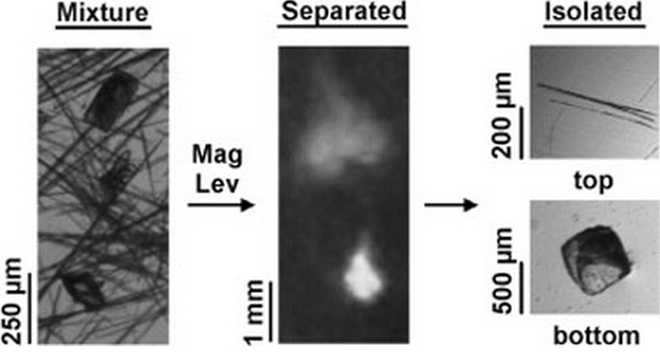New Method Uses Magnetic Levitation to Separate Polymorphic Crystals


Magnetic levitation (MagLev) provides a simple method for the separation of crystal polymorphs that differ in density by greater than 0.001 g/cm^3. Density-based separations of multiple crystalline forms were shown for four organic compounds: 5-methyl-2-[(2-nitro- phenyl)amino]-3-thiophenecarbonitrile, sulfathiazole, carbamazepine, and trans- cinnamic acid.
Many organic substances have the property of forming multiple crystal structures. These multiple crystal structures of the same compound are known as polymorphs. As the crystal structure varies, many physical properties of the substance, including solubility and rate of dissolution also varies.
When it comes to crystalline pharmaceuticals, variations in solubility and rate of dissolution also affect the bioavailability of drugs. Similarly, polymorphs can also cause variations in colours and sensitivity in dyes, pigments and explosives respectively. As it is virtually impossible to control the crystallization process to produce a single type of polymorph, researchers from Massachusetts Institute of Technology (MIT) have developed a new method to separate these polymorphs easily using magnetic levitation (MagLev).
This new method exploits the fact that substances with different crystalline structures have different densities to achieve separation of polymorphs within minutes. In this method, a tube containing polymorphs suspended in a paramagnetic fluid is placed inside a magnetic field. The counteracting magnetic field and gravitation force causes the crystals to reach the equilibrium point inside the paramagnetic fluid where the gravitation force and magnetic attraction on the volume of paramagnetic fluid equivalent to that of the crystals is balanced, causing the crystals to float in the paramagnetic fluid. Crystals with different crystalline structures, having different densities will have different floating points as the strength of gravitational force depends upon the density of the crystal. Crystals at different floating points are then collected, leading to easy, fast and reliable separation of polymorphs. Further information about the study can be obtained in the journal, Angewandte Chemie.
